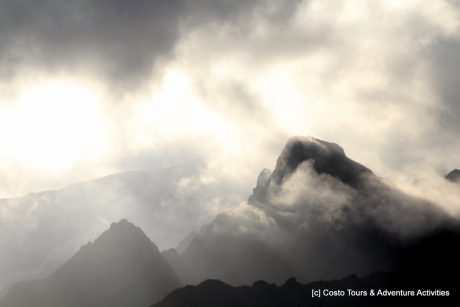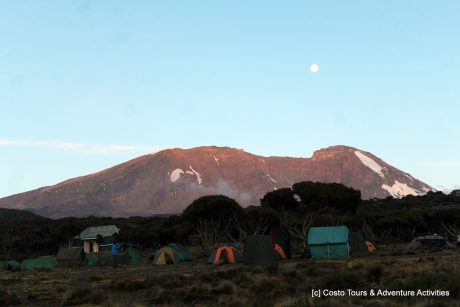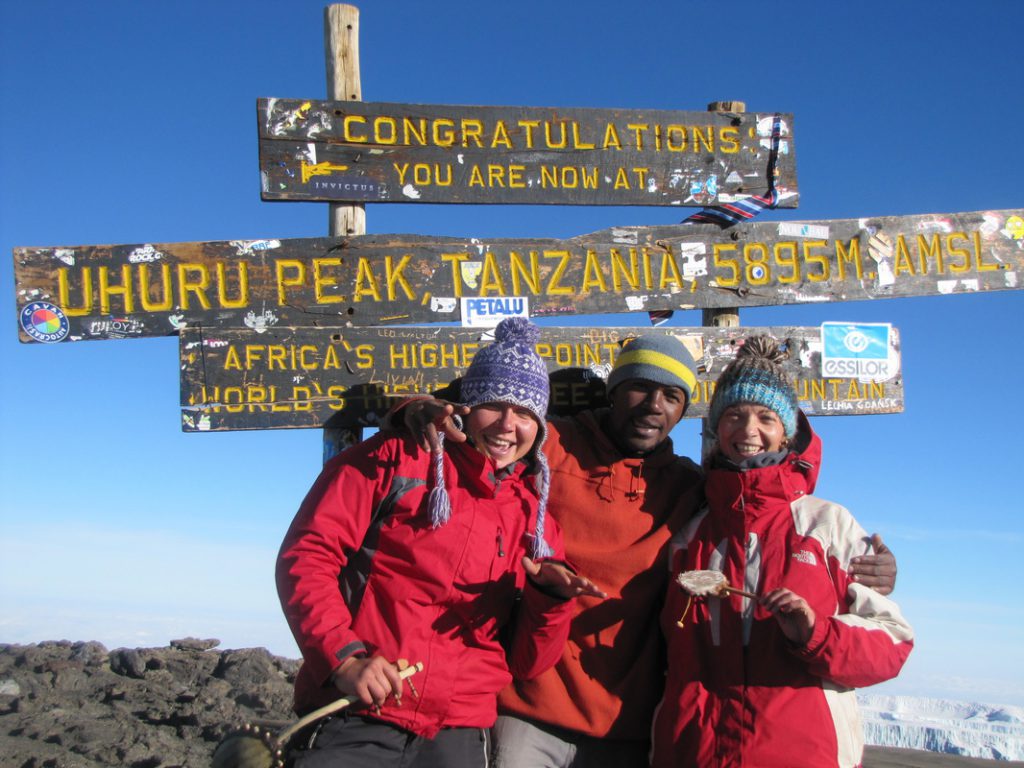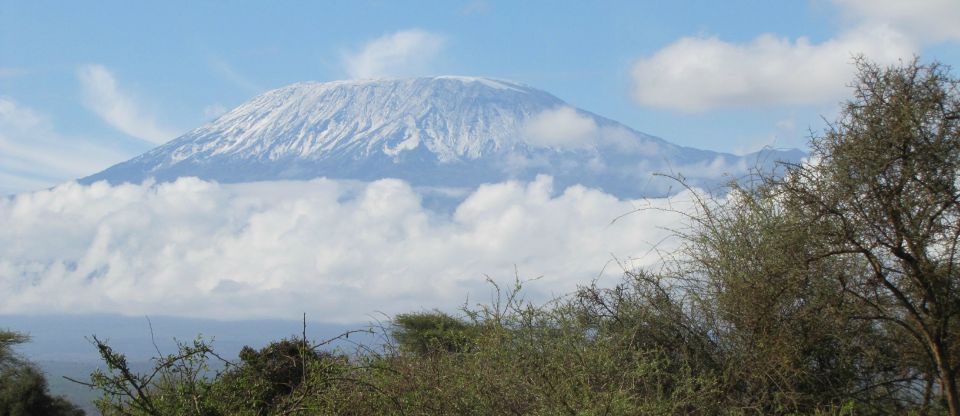Mount Kilimanjaro.
Mount Kilimanjaro, with is three cones Kibo, Mawenzi and Shira, is a dormant volcanic mountain in Tanzania. It is the highest mountain in Africa standing at 5,895 (19,341 feet) metres above sea level and is also the highest free standing mountain in the world. Uhuru peak is the highest summit on Kibo’s crater rim.
Unlike other snow-capped mountains in the world, Kilimanjaro is not a technical climbing mountain and the summit can be reached just on foot on one of five ascending routes available. What you will need to reach the roof of Africa will be walking sticks, proper mountain climbing clothes, good hiking boots, head torch, food, tents, drinking water and a lot of will power and courage. Although it sounds easy, one should not take this mountain lightly and should prepare themselves physically and mentally as you will need a fit body and a strong mental will to get to the summit. Otherwise, it is an experience of lifetime!
Ascent Routes.


This is the second most popular route on the mountain with amazing scenic views as you ascend to the summit. The route is typically done on a six or seven day hike and will take you through the following camps:
- Machame gate (start of the trek) – 1,743m a.s.l (5,718 ft)
- Machame Hut/Camp – 3,026m a.s.l (9,927 ft)
- Shira Camp – 3,766m a.s.l (12,355 ft)
- Barranco – 3,983m a.s.l (13,066 ft)
- Karanga (optional camp, used by 7-day climbers)
- Barafu (high camp before summit) 15,239 feet (4,645 m)
- Uhuru peak – 5,895m a.s.l (19,341 ft)
- Mweka (descent) – 3,110m a.s.l (10,204 ft)
- Mweka Gate (end of trek) – 1,653m a.s.l (5,423 ft).
2. Marangu Route
- Day 1 – Drive to Marangu Gate. Walk through the rain forest to Mandara hut 2,743m a.s.l (8,999 ft), about 3 hours hike.
- Day 2 – Leave the forest and cross open moorland to Horombo hut (3,760 metres (12,340 ft)).
- Day 3 – Rest and acclimatisation day at Horombo Hut. Day walk to Zebra Rocks or to Mawenzi Hut. This day can be omitted.
- Day 4 – Walk through moorland then alpine desert to “The Saddle” between the peaks of Mawenzi and Kibo. From here you will walk for about an hour to reach Kibo hut 4,730m a.s.l (15,520 ft)).
- Day 5 – Very early start for the summit on steep scree up to Gillman’s Point 5,681m a.s.l (18,638 ft), which is on the crater rim. Continue around the rim which will take about two hours if you are fit to Uhuru Peak 5,895 metres (19,341 ft), the highest point in Africa. Descend to Kibo Hut and then down to the thicker air and relative warmth of Horombo hut.
- Day 6 – Descend to Marangu gate.
3. Umbwe Route.
- Day 1 – Drive to the Umbwe Roadhead at 1,800m a.s.l (5,900 ft). The route initially follows a forestry track winding up through the natural rain forest. It then narrows and steepens to climb the ridge between the Lonzo and Umbwe rivers. The first campsite is in the forest by some rock overhangs at 2,940 metres (9,650 ft), about a 5 – 6 hour trek.
- Day 2 – Shortly after leaving the camp, the forest ends and the path continues along a narrow spectacular ridge. Above, the sheer 1,000 metres (3,300 ft) of the Breach Wall appears and disappears as the afternoon mists roll up the Great Barranco. From the Umbwe ridge the route descends slightly to the Barranco Hut and the camp in the valley floor at 3,900m a.s.l (12,800 ft), a 5 – 6 hour trek.
- Day 3 – From here the route parts. The traditional route continues north to climb the Western Breach from the Arrow Glacier Camp. However, because of the high risk from falling rock, it is suggested to follow the route below:
- A short scramble to the top of the Great Barranco Wall and then a traverse over scree and ridges to the Karanga Valley 4,000m a.s.l (13,000 ft), 3 hour trek, beneath the ice – falls of the Heim, Kersten, and Decken Glaciers.
- After climbing out of the Karanga Valley, the trail ascends a ridge to the Barafu Hut, a bleak location with little vegetation at 4,600m a.s.l (15,100 ft), a 3 hour trek.
- Day 4 – An early start for the ascent to the rim of the Kibo Crater between the Rebmann and Ratzel Glaciers, about a 4 hour trek. The last section before the rim can sometimes be snow-covered and an ice-axe or ski stick is useful for balance. From here, a further hour leads to Uhuru Peak, from where there are often fine views of Mount Meru to the west and the jagged peak of Mawenzi to the east. After a short time on the summit, descend to the Barafu Hut before continuing on down to camp at Mweka Hut in the giant heather zone on the Mweka route.
- Day 5 – After breakfast, a 3 to 4 hour descent through forest brings you to the park gate.
4. Lemosho Route.
- Day 1 – Drive from Moshi or Arusha to Londorossi Park Gate 2,250m a.s.l (7,380 ft), about a 2 hour drive. From here a forest track requiring a four wheel drive vehicle leads to Lemosho Glades 2,100m a.s.l (6,900 ft), 11 kilometres (6.8 mi), 45 minute drive and a possible campsite (park fees are not paid to camp here). Walk along forest trails to Mti Mkubwa (big tree) campsite, 2,750m a.s.l (9,020 ft), 3 hours trek.
- Day 2 – The trail gradually steepens and enters the giant heather moorland zone. Several streams are crossed then it gains the Shira Ridge at about 3,600m a.s.l (11,800 ft) and drops gently down to Shira 1 camp located by a stream on the Shira Plateau 3,500m a.s.l (11,500 ft), 7 hour trek. This campsite could be omitted.
- Day 3 – A gentle walk across the plateau leads to Shira 2 camp on moorland meadows by a stream 3,850m a.s.l (12,630 ft), 4 hours trek. A variety of walks are available on the plateau making this an excellent acclimatization day.
- Day 4 – Continue east towards Kibo passing the junction, then east towards the Lava Tower. Shortly after this, you descend to Barranco hut 3,940m a.s.l (12,930 ft), 6 hour trek.
- Day 5 – A short scramble to the top of the Great Barranco and then a traverse over scree and ridges to the Karanga Valley 4,000m a.s.l (13,000 ft), 3 hour trek beneath the ice – falls of the Heim, Kersten, and Decken Glaciers. After climbing out of the Karanga Valley, the trail ascends a ridge to the Barafu Hut, a bleak location with little vegetation at 4,600m a.s.l (15,100 ft), 3 hours trek.
- Day 6 – An early start for the ascent to the rim of the Kibo Crater between the Rebmann and Ratzel Glaciers, (6 hour trek). The last section before the rim can sometimes be snow-covered and an ice-axe or ski stick is useful for balance. At the rim, Stella point is reached 5,685m a.s.l (18,652 ft). From here, a further hour leads to Uhuru Peak 5,895m a.s.l, from where there are often fine views of Meru to the west and the jagged peak of Mawenzi to the east. Descend to the Barafu Hut (3 hour trek) for a rest and lunch before continuing on past Millenium camp down to camp at Mweka Hut in the giant heather zone on the forest edge (4 hours trek). Those with energy on the summit may wish to descend to the Reutsh Crater and visit the ice pinnacles of the Eastern Ice – fields.
- Day 7 – After breakfast, a 3-4 hour descent through forest brings you to the park gate.
5. Rongai Route
- Day 1 – Drive 2 hours from the Marangu gate to the Rongai Gate. Walk to Simba Camp at 2,650m a.s.l (8,690 ft) a 2.5-3 hour trek. The walk is initially through plantations then rain forest and finally bush country.
- Day 2 – Walk to second Cave at 3,450m a.s.l (11,320 ft), 3½ hour trek. A gentle day through bush then heathers.
- Day 3 – Gentle rising traverse through moorland over several ridges to Kikelea Caves, 3,600m a.s.l (11,800 ft), 3 hours trek. Moorland then screes to Mawenzi Tarn Hut, 4,330m a.s.l (14,210 ft), 3-3.5 hours trek.
- Day 4 – Easy angled screes slopes lead across the Saddle to Kibo Hut, 4,700 metres (15,400 ft), 4.5-5 hrs.
- Day 5 – Very early start for the summit on steep scree up to Gillman’s Point 5,681m a.s.l (18,638 ft), which is on the crater rim. Continue around the rim, which will take about two hours if you are fit, to Uhuru Peak 5,895m a.s.l (19,341 ft) the highest point in Africa. Descend to Kibo Hut and then down to the thicker air and relative warmth of Horombo hut.
- Day 6 – After breakfast, Descend to Marangu gate to finish your trek.
- Climbers often omit the second cave during ascent, although the climb is more difficult.
Email us with your inquiry and we shall help and advise you on the best route to take for your climb depending on time, age, physical and health restrictions. The ‘Kili” climb can also be combined with a safari either in Kenya or Tanzania and a beach holiday so please let us know what you prefer and we will be happy to tailor-make your itinerary to fit your specifications.



